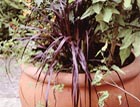Planting to Beat the Hosepipe Bans
The hosepipe ban has affected different gardeners in different ways; Mark Griffiths shares his tips for how to make the most of limited amounts of water in this hot weather.


July 27, 2006
The hosepipe ban has affected my gardening chums in different ways. One, whose garden remains suspiciously verdant, has acquired a wardrobe of SAS-style cloth-ing and a profound knowledge of the night sky. Then there is a confirmed bachelor of our acquaintance who has bought himself a children's paddling pool which he nervously moves about the garden as if trying to placate a gaggle of ghostly infant bathers. Some have asked why this fellow always fills his new toy to bursting point. But then paddling pools are not yet verboten. In my own case, the ban has driven me to pot, or pots, and I am focusing my Jean de Florette like anxieties on a few new containers that will need no more than a couple of weekly cans apiece.
My guide in this was Robert Moy of Tuscan Pots in Oxford's Botley Road. He likes to travel to find things for our gardens, with the result that his empor-ium looks not unlike a field station of the Sir John Soane's Museum. A bust of Nero peers from behind a Chinese celadon rice jar. Olives, citrus and jasmine abound amid Corinthian capitals and Venetian vases. Pieces in gaily painted majolica rub shoulders with stately urns moulded in Impruneta clay. I acquire two types of pot for two types of look: squat bowls in thick terracotta, and sharp edged boxes cast in a newish stone-based resin whose glaucous, slatey appearance more than dispels any qualms about its being man made.
In each case, I go for a mother-and-child pairing one little, one large to sit side by side. All, of course, have decent sized drainage holes. I call them go-to-hell (hot, spicy and to blazes with good taste) for the terracotta, and marmoreal monochrome (greens and whites only with the emphasis on sculptural foliage) for the ash black resin. The first is for a sunny terrace beside an assortment of Mediterranean type plants; the second for a secluded spot with bamboos and big-leaved exotics.
The black pots brim with white calla lilies (Zantedeschia aethiopica) and the African rush Chondropetalum tectorum. Spilling down their sides is the penny leaved Dichondra Emerald Falls, and towering at the centre is a specimen of Musa itinerans Yunnan, a recently introduced semi-hardy banana with silvered leaf stalks. I should add that this is no window box: the whole ensemble stands about 8ft tall.
The terracotta spice mix includes tawny orange abutilons, Mimulus auran-tiacus and dwarf petunias, flame-red Salvia fulgens and Cuphea Georgia Scarlet, and the ubiquitous, but peerless, golden trailing daisy Bidens ferulifolia. To bank up the fire a touch, contrast and depth are provided by the maroon foliage of the ornamental sweet potato Ipomoea Blackie and the purple fountain grass Pennisetum setaceum Rubrum. To add height, and interest, later in the season, there is a centerpiece for each pot: in one, a small lemon tree bristling with new-set fruit; in the other, the Andean angel's trumpets Brugmansia sanguinea, hung with apricot and vermilion-banded flutes.
The trick is not to be confined by the trade's categories of what is suitable for a pot, but to scour the bedding, conservatory and hardy sections of the garden centre for whatever plants please you and are roughly compatible. Then combine them in what is really a bouquet with roots, bearing in mind that they will need to rub along together for at least the next four months. Some of these (petunias, dichondra and bidens) are disposable bedders that will end their lives on the compost heap this year. Others (the calla lilies, lemon tree, African rushes and bananas) are precious and permanent accessions that will find new homes in sheltered spots in the garden as they outgrow their containers in a year or two. Yet others (salvia, abutilon, mimulus, brugmansia and the fountain grass), I will separate out in the autumn and overwinter under frost-free glass before recycling them next summer.
Exquisite houses, the beauty of Nature, and how to get the most from your life, straight to your inbox.
As weight is not a worry, I have used good-old John Innes number 3 potting mixture, with a little soilless potting compost. To this, I have not added the water-retaining gel that is selling so well. I find it sours the compost and leads to poor rooting. In any case, it is unnecessary for the sake of these few pots, I can still lift a can. When that fails, I know a chap with a paddling
This article first appeared in COUNTRY LIFE magazine on July 27, 2006
Country Life is unlike any other magazine: the only glossy weekly on the newsstand and the only magazine that has been guest-edited by His Majesty The King not once, but twice. It is a celebration of modern rural life and all its diverse joys and pleasures — that was first published in Queen Victoria's Diamond Jubilee year. Our eclectic mixture of witty and informative content — from the most up-to-date property news and commentary and a coveted glimpse inside some of the UK's best houses and gardens, to gardening, the arts and interior design, written by experts in their field — still cannot be found in print or online, anywhere else.
